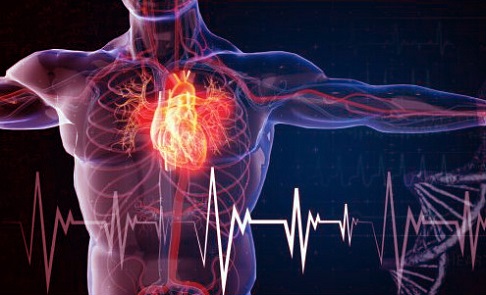Nikhil Prasad Fact checked by:Thailand Medical News Team Dec 04, 2024 4 months, 1 week, 2 days, 2 hours ago
Medical News:
A Hidden Key to Cardiac Disease
Mitochondria, the tiny energy factories within our cells, play a crucial role in powering the heart. Scientists from the National and Kapodistrian University of Athens and Hygeia Hospital in Greece have reviewed how mitochondrial dysfunction significantly impacts cardiac health. This
Medical News report aims to make this complex topic understandable to everyone while highlighting essential findings.
 Mitochondria and Heart Health
Why Mitochondria Matter
Mitochondria and Heart Health
Why Mitochondria Matter
The heart is an organ that works tirelessly, beating about 100,000 times a day. To maintain this extraordinary effort, it relies on a continuous energy supply, primarily in the form of ATP. Mitochondria are responsible for producing over 95% of this ATP. They not only fuel heartbeats but also regulate calcium levels, which are vital for muscle contraction and relaxation.
When mitochondria fail to function properly, it sets off a chain of events leading to energy deficits and accumulation of harmful substances, such as free radicals and misfolded proteins. These disruptions weaken the heart, contributing to conditions like heart failure.
Understanding Mitochondrial Dynamics
Mitochondria are not static entities. They constantly undergo changes through processes known as fission and fusion, which help maintain their health. Fission allows damaged parts to be removed, while fusion helps repair these energy-producing units. When this delicate balance is disturbed, mitochondria become dysfunctional, impacting the heart's ability to pump effectively.
As researchers have noted, the heart consumes roughly 6 kilograms of ATP daily, with the majority supporting its contractile functions. In heart failure, mitochondrial fission increases, causing fragmentation and further energy loss. Fusion, which can counteract this, often becomes less efficient, leaving the heart more vulnerable to damage.
The Protective Role of Mitophagy
Mitophagy is the process of clearing out damaged mitochondria to make way for healthy ones. In early stages of heart failure, mitophagy ramps up as a defense mechanism. However, as the condition progresses, this system becomes overwhelmed, allowing damaged mitochondria to accumulate.
This study emphasizes how crucial it is to understand these processes. The research highlights how mitochondrial proteins, such as PINK1 and Parkin, play roles in initiating mitophagy. When these mechanisms fail, the heart becomes prone to further damage, leading to a vicious cycle of energy depletion and cell death.
Mitochondria's Social Network
Mitochondria do not work alone. They interact with other cellular structures, like the endoplasmic reticulum (ER), which is essential for calcium transfer and lipid metabolism. Disruptions in these interactions can lead to severe consequences, including oxidative stress and inflammation, both of which are hallmarks of heart disease.
&l
t;br />
One fascinating discovery is the presence of cell-free mitochondria in the bloodstream. While their role is still being explored, these free-floating mitochondria might offer clues to disease progression and potential therapeutic targets.
Emerging Therapies
Researchers are exploring treatments targeting mitochondrial dysfunction. Quadruple therapy, which combines beta-blockers, RAAS inhibitors, SGLT2 inhibitors, and neprilysin inhibitors, has shown promise in improving mitochondrial function. These therapies help reduce oxidative stress, improve energy production, and support the heart’s metabolic needs.
For instance, SGLT2 inhibitors have been found to enhance mitochondrial resilience and energy efficiency. They shift the heart’s fuel preference to ketones, a more efficient energy source, reducing the workload on failing mitochondria.
Challenges and Future Directions
While significant progress has been made, challenges remain. Imaging techniques like PET scans and magnetic resonance spectroscopy offer insights into mitochondrial health but are expensive and not widely accessible. Similarly, biomarkers such as mitochondrial DNA and specific proteins hold potential but require further validation.
Scientists are also investigating lifestyle interventions, like exercise and calorie restriction, which appear to boost mitochondrial function. Regular physical activity has shown to increase the expression of protective proteins, helping mitochondria adapt and survive under stress.
Conclusions
Mitochondria are at the heart of cardiac health, influencing energy production, calcium regulation, and cell survival. When they fail, the repercussions are profound, leading to conditions like heart failure. Understanding and targeting mitochondrial dysfunction offers a promising avenue for improving cardiac care.
The study underscores the importance of further research to unravel the complexities of mitochondrial dynamics and their role in disease. As researchers from Athens and Hygeia Hospital concluded, addressing mitochondrial dysfunction could hold the key to more effective treatments.
The study findings were published in the peer-reviewed journal: Biomolecules.
https://www.mdpi.com/2218-273X/14/12/1534
For the latest on Heart Issues, keep on logging to Thailand
Medical News.
Read Also:
https://www.thailandmedical.news/news/canadian-scientists-alarmingly-find-that-weight-loss-drugs-ozempic-and-wegovy-cause-heart-muscles-to-shrink
https://www.thailandmedical.news/news/new-findings-link-heart-arrhythmias-to-upper-gi-disorders
https://www.thailandmedical.news/news/new-study-warns-of-heart-and-kidney-risks-associated-with-the-common-pain-reliever-etoricoxib
